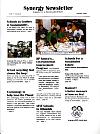

synergy vol 1 issue 2
The Next
Reformation
an interview
with Paul Hawken, by Sarah Van Gelder
Part
4
Sarah: You're talking about the kind of work being done with energy efficiency and so forth?
Paul: Yes, energy efficiency, material efficiency, and system efficiency. The term used commonly in Europe now is "factor" for the amount of efficiency, "factor four" being four times as efficient, or a 75 percent reduction in throughput of energy and materials.
State-of-the-art thinking now, led by Amory and Hunter Lovins of Rocky Mountain Institute, and Ernst von Wieszacker of the Wuppertal Institute in Germany, is that we are going to a factor ten economy, an economy that allows us to do what we do now with 90 percent less energy and materials. I agree. That's the future, and those companies that understand it and move first - and I should say those countries, too - will find themselves in an advantaged position throughout the coming decades and century.
The good news is that the perverse incentives that have characterized industrial market economies are gradually failing, despite the best efforts of national legislatures to keep them in place, and there are now positive incentives to move towards efficient and sustainable systems that do not rely on altruism or regulation. I'm not against altruism, or against regulation either, but these new systems are self-regulating. It's very exciting.
Sarah: Which companies are catching on to this? Where do you see progress being made?
Paul: In many cases, the leaders are companies that would bore or shock you, either because most people have never heard of them or because they've been some of the worst despoilers of natural systems in their products and processes. Some of these companies are now becoming quite taken by factor four efficiencies because they have huge problems, both from the past and in the present, and thus they have the most to gain from a wholesale revision of what business they're in, how they conduct themselves, and how they design their processes. It is not for me to say who they are because they are in mid-transition and have not made their intentions known publicly or to their shareholders. And there is always the chance that a new CEO could kill those initiatives.
Sarah: What is the motivation for these large companies to change?
Paul: It varies. In some cases the CEO got religion. In some cases it's because they've been badly burned and chastised, and they'll try anything. They're open and they've been made open by failure.
Sarah: One of the things that seems to be getting in the way of a real transformation is the amount of investment that is already sunk into our current way of doing things.
Paul: Yes, and that's why any systems change has to refrain from punishing current investment within a 15-20 year time line. So often, well-intended regulation has punished capital investments that were made in good faith - maybe not good science, but good faith. Any company whose capital investments are affected by such regulations will be tigers in opposing new standards or laws that basically create write offs. An intelligent strategy of moving towards a least-cost, carbohydrates-based, cyclical economy that rewards resource efficiency rather than only financial efficiency, has to be as imaginative as the very processes it seeks to replicate. Intelligent policies will be largely self-regulating in the sense that the system of incentives and standards makes it absolutely ludicrous to not move towards clean, internalized systems of cost and production.
![]()
SFSF
Schools For a Sustainable Future

1 Curdies St.
E. Bentleigh Vic. 3165
Email:
Joe Natoli
Ph: (03) 9579-7224 Fax:
(03) 9579-6153 Mobile: 0411-568-523
Website
designed & maintained by
